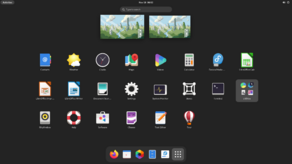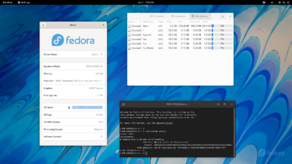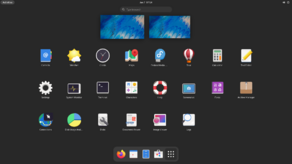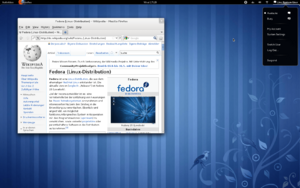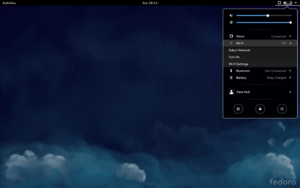Fedora Linux facts for kids
 |
|
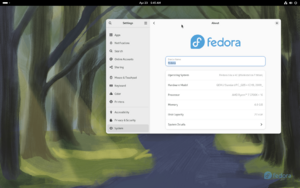
Fedora Workstation 40
|
|
| Company / developer | Fedora Project |
|---|---|
| OS family | Linux (Unix-like) |
| Working state | Current |
| Source model | Open source |
| Initial release | November 4, 2003 |
| Latest stable release | 40 |
| Latest unstable release | 41 Beta / 17 September 2024 |
| Marketing target | Desktop computers, servers, supercomputers |
| Package manager | RPM (DNF), Flatpak, OSTree |
| Supported platforms | |
| Kernel type | Monolithic (Linux kernel) |
| Userland | GNU |
| Default user interface | GNOME Shell, Bash |
| License | GPL and various free software licenses, plus proprietary firmware files |
Fedora Linux is a type of Linux distribution. It is like a complete computer operating system. The Fedora Project develops it.
Fedora started in 2003. It continued the work of an older project called Red Hat Linux. Fedora uses software that is free and open-source. This means anyone can use, change, and share it. Fedora aims to be a leader in new open-source technologies. It is also the base for other Linux systems like CentOS Stream and Red Hat Enterprise Linux.
Since 2014, Fedora has offered different versions, called "editions." These include versions for personal computers, servers, and cloud computing. By 2022, it added editions for containers and Internet of Things (IoT) devices. A new version of Fedora Linux comes out about every six months.
As of 2016, about 1.2 million people use Fedora Linux. Even Linus Torvalds, who created the Linux kernel, uses Fedora.
Contents
What Fedora Linux Can Do
Fedora is known for being innovative. It often adds new technologies early on. The Fedora team works closely with other Linux groups. This helps make sure new features are available to all Linux distributions, not just Fedora.
How Fedora Updates
Each version of Fedora Linux is supported for at least 13 months. This means you get updates and fixes for that long. New versions are released about every six months. You can easily upgrade Fedora from one version to the next without reinstalling everything.
Desktop Look and Feel
The main way Fedora looks and feels is with something called GNOME. This is its default desktop environment. But you can choose other desktop styles too. These include KDE Plasma, Xfce, LXQt, and many others.
You can even try Fedora Linux without installing it. You can create a "live media" drive using a USB stick. This lets you test Fedora without changing anything on your computer's hard drive.
Managing Software
Most Fedora Linux versions use the RPM system. They use a tool called DNF to manage software. DNF helps install, update, and remove programs. Fedora also includes Flatpak by default. Flatpak is another way to get and run applications.
Some special Fedora versions, like CoreOS and Silverblue, use a different system. They use something called rpm-ostree. This helps them manage software in a unique way, often for virtual computers.
Keeping Your Computer Safe
Fedora Linux has strong security features built in. It uses Security-Enhanced Linux (SELinux) to protect your system. SELinux helps control what programs can do. Fedora also makes its software packages safer by using special compiler features. It also comes with firewalld, which acts as a firewall to block unwanted network traffic.
Programs You Can Use
Fedora Workstation comes with many programs already installed. These include LibreOffice (like Microsoft Office) and Firefox (a web browser). You can get more software from "software repositories." Think of these as online stores for programs. You can install them using DNF or GNOME Software.
You can also add other repositories. This lets you install software not found in Fedora's official stores. Sometimes, software isn't in the official Fedora repositories because of licensing rules or US laws. For these, you can use third-party repositories like RPM Fusion. Fedora also lets users create their own software repositories easily with a system called Copr.
Since Fedora 25, the system uses Wayland for displaying graphics. This is a newer technology than the older X Window System.
How to Install Fedora
Fedora Linux uses a program called Anaconda to install the system. It guides you through the setup process.
Different Versions of Fedora
Starting with Fedora 21, there were three main versions. By version 37, this expanded to five main versions.
Workstation Edition
This version is for people who use laptops or desktop computers. It's designed to be easy to use and powerful. It comes with GNOME as the default desktop. But you can install other desktop environments or get a "Spin" that already has a different one.
Silverblue
Silverblue is a special type of Fedora Workstation. It's called an "atomic desktop" system. This means every Silverblue installation is exactly the same as others of the same version. It also doesn't change much as you use it. This design makes the operating system more stable and less likely to have bugs. It's also easier to test and develop.
Silverblue is great for apps that run in containers. These apps are kept separate from the main system. Updates are very fast, and you can even go back to an older version if something goes wrong.
Server Edition
This version is made for servers. Servers are powerful computers that store and manage data. This edition includes the newest technologies for data centers. It doesn't come with a desktop environment, but you can add one.
IoT Edition
This version of Fedora Linux is made for Internet of Things (IoT) devices. These are small devices like smart home gadgets. It works on different types of processors, including those found in many IoT devices.
CoreOS Edition
CoreOS is a very minimal version of Fedora Linux. It includes only the basic parts needed to run. It's designed for use in cloud computing. It's great for deploying containers, which are like small, self-contained packages for software.
Fedora Labs
The Fedora Project also offers special versions called Fedora Labs. These are Fedora Linux with specific software packages. They are made for certain interests. For example, there are Labs for gaming, security, design, robotics, and science.
Spins and Remixes
"Fedora Spins" are official versions of Fedora Linux that come with different desktop environments. While GNOME is the default, Spins offer choices like KDE Plasma, Xfce, Cinnamon, and more. Some Spins, like Kinoite, are also "immutable" like Silverblue.
"Fedora Remixes" are unofficial versions. They are also based on Fedora but are created by other groups.
Computer Architectures
Fedora primarily supports x86-64 and ARM AArch64 computer architectures. These are the types of processors found in most modern computers and many mobile devices. Fedora also supports other architectures like IBM Power64le and RISC-V as secondary options.
History of Fedora
The name "Fedora" comes from two things. First, it was the name of an old volunteer project. This project added extra software to Red Hat Linux. Second, it comes from the fedora hat in Red Hat's old logo.
Warren Togami started the original Fedora Linux project in 2002. He wanted a single place for well-tested software packages. This would make it easier to find and use software not made by Red Hat. The key idea was that Fedora would be a team effort with volunteers from all over the world. This collaborative idea became a big part of the Fedora Project.
Fedora Linux, first called "Fedora Core," started in 2003. This happened when Red Hat Linux stopped being developed. Red Hat wanted to focus on its paid version for servers, Red Hat Enterprise Linux. Fedora then became the community-driven version. New versions of Red Hat Enterprise Linux are often based on Fedora.
Before Fedora 7, Fedora Linux had two main parts: Core and Extras. Fedora Core had the main parts of the operating system. Red Hat developers maintained it. Fedora Extras had more software and was maintained by the community. With Fedora 7, these two parts were combined.
In April 2020, Fedora Workstation became available on some new ThinkPad laptops. This was thanks to a partnership with Lenovo.
How Fedora is Developed
The Fedora Project leads the development of Fedora Linux. It's a community of developers and volunteers. Many Red Hat employees also work on Fedora.
The Fedora Council is the main leadership group. Other groups, like the Fedora Engineering Steering Committee, make technical decisions. The Fedora Mindshare Committee handles things like outreach and marketing.
Fedora Releases

Fedora versions have a relatively short lifespan. Each version is supported for at least 13 months. New versions come out about every six months. You can easily upgrade Fedora without reinstalling the whole system.
The current version is Fedora 40, released on April 23, 2024.
| Version | Release | End-of-life | Kernel | GNOME |
|---|---|---|---|---|
| 1 (Yarrow) | 2003-11-06 | 2004-09-20 | 2.4.22 | 2.4 |
| 2 (Tettnang) | 2004-05-18 | 2005-04-11 | 2.6.5 | 2.6 |
| 3 (Heidelberg) | 2004-11-08 | 2006-01-16 | 2.6.9 | 2.8 |
| 4 (Stentz) | 2005-06-13 | 2006-08-07 | 2.6.11 | 2.10 |
| 5 (Bordeaux) | 2006-03-20 | 2007-07-02 | 2.6.15 | 2.14 |
| 6 (Zod) | 2006-10-24 | 2007-12-07 | 2.6.18 | 2.16 |
| 7 (Moonshine) | 2007-05-31 | 2008-06-13 | 2.6.21 | 2.18 |
| 8 (Werewolf) | 2007-11-08 | 2009-01-07 | 2.6.23 | 2.20 |
| 9 (Sulphur) | 2008-05-13 | 2009-07-10 | 2.6.25 | 2.22 |
| 10 (Cambridge) | 2008-11-25 | 2009-12-18 | 2.6.27 | 2.24 |
| 11 (Leonidas) | 2009-06-09 | 2010-06-25 | 2.6.29 | 2.26 |
| 12 (Constantine) | 2009-11-17 | 2010-12-02 | 2.6.31 | 2.28 |
| 13 (Goddard) | 2010-05-25 | 2011-06-24 | 2.6.33 | 2.30 |
| 14 (Laughlin) | 2010-11-02 | 2011-12-08 | 2.6.35 | 2.32 |
| 15 (Lovelock) | 2011-05-24 | 2012-06-26 | 2.6.38 | 3.0 |
| 16 (Verne) | 2011-11-08 | 2013-02-12 | 3.1 | 3.2 |
| 17 (Beefy Miracle) | 2012-05-29 | 2013-07-30 | 3.3 | 3.4 |
| 18 (Spherical Cow) | 2013-01-15 | 2014-01-14 | 3.6 | 3.6 |
| 19 (Schrödinger's Cat) | 2013-07-02 | 2015-01-06 | 3.9 | 3.8 |
| 20 (Heisenbug) | 2013-12-17 | 2015-06-23 | 3.11 | 3.10 |
| 21 | 2014-12-09 | 2015-12-01 | 3.17 | 3.14 |
| 22 | 2015-05-26 | 2016-07-19 | 4.0 | 3.16 |
| 23 | 2015-11-03 | 2016-12-20 | 4.2 | 3.18 |
| 24 | 2016-06-21 | 2017-08-08 | 4.5 | 3.20 |
| 25 | 2016-11-22 | 2017-12-12 | 4.8 | 3.22 |
| 26 | 2017-07-11 | 2018-05-29 | 4.11 | 3.24 |
| 27 | 2017-11-14 | 2018-11-30 | 4.13 | 3.26 |
| 28 | 2018-05-01 | 2019-05-28 | 4.16 | 3.28 |
| 29 | 2018-10-30 | 2019-11-26 | 4.18 | 3.30 |
| 30 | 2019-05-07 | 2020-05-26 | 5.0 | 3.32 |
| 31 | 2019-10-29 | 2020-11-24 | 5.3 | 3.34 |
| 32 | 2020-04-28 | 2021-05-25 | 5.6 | 3.36 |
| 33 | 2020-10-27 | 2021-11-30 | 5.8 | 3.38 |
| 34 | 2021-04-27 | 2022-06-07 | 5.11 | 40 |
| 35 | 2021-11-02 | 2022-12-13 | 5.14 | 41 |
| 36 | 2022-05-10 | 2023-05-16 | 5.17 | 42 |
| 37 | 2022-11-15 | 2023-11-14 | 6.0 | 43 |
| 38 | 2023-04-18 | 2024-05-14 | 6.2 | 44 |
| 39 | 2023-10-17 | 2024-11-12 | ||
| 40 | 2024-04-16 | 2025-05-13 | ||
|
Legend:
Old version
Older version, still maintained
Latest version
Latest preview version
Future release
|
||||
Timeline generation failed: 1 error found
Line 33: at:17/12/2025 color:today width:0.1
- LineData attribute 'at' invalid.
Date '17/12/2025' not within range as specified by command Period.
Rawhide
Rawhide is the "development tree" for Fedora. It's where new software is added and tested before it goes into a stable release. Rawhide often has the newest features. It's for advanced users, testers, and developers. Rawhide users often update their systems daily and help find problems. They don't need to upgrade between different versions because it's a "rolling release" system, always getting the latest updates.
Images for kids
See also
 In Spanish: Fedora (sistema operativo) para niños
In Spanish: Fedora (sistema operativo) para niños



